
Sceliphron, also known as black mud daubers or black mud-dauber wasps, is a genus of Hymenoptera of the Sphecidae family of wasps. They are solitary mud daubers and build nests made of mud. Nests are frequently constructed in shaded niches, often just inside of windows or vent openings, and it may take a female only a day to construct a cell requiring dozens of trips carrying mud. Females will add new cells one by one to the nest after each cell is provisioned. They provision these nests with spiders, such as crab spiders, orb-weaver spiders and jumping spiders in particular, as food for the developing larvae. Each mud cell contains one egg and is provided with several prey items. Females of some species lay a modest average of 15 eggs over their whole lifespan. Various parasites attack these nests, including several species of cuckoo wasps, primarily by sneaking into the nest while the resident mud dauber is out foraging.

The Megaspilidae are a small hymenopteran family with 13 genera in two subfamilies, and some 450 known species, with a great many species still undescribed. It is a poorly known group as a whole, though most are believed to be parasitoids, and a few hyperparasitoids. Many are found in the soil, and of these, a number are wingless.

Bembix is a large cosmopolitan genus of large, often brightly colored predatory sand wasps, consisting of about 380 species.

Pepsis is a genus of spider wasps belonging to the family Pompilidae. Species within this genus are also called tarantula hawks, as they usually hunt tarantulas, similarly to many species in the genus Hemipepsis. These wasps are restricted to the Americas, with the related genus Hemipepsis occurring in both Old and New Worlds.
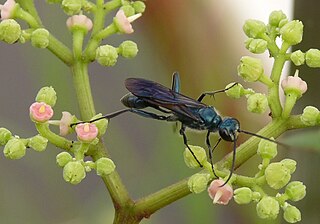
Chalybion is a genus of blue mud dauber wasps in the family Sphecidae. Chalybion species nest in a wide range of natural and artificial cavities such as holes in wood, walls, plant stems, etc., where they typically provision their brood cells with paralyzed spiders. They also reuse old nests of other wasps like Trypoxylon and Sceliphron.
Homonotus is a genus of spider hunting wasps with an old world distribution, mainly in Africa.
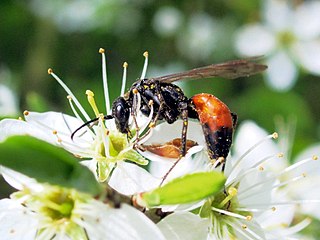
Priocnemis is a genus of pepsine spider wasp containing around 30 species.
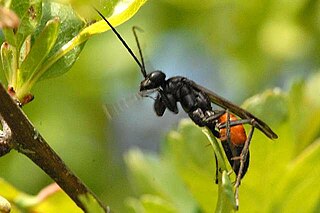
Arachnospila is a predominantly Holarctic genus of spider wasps, with limited representation in montane habitats in Neotropical and Afrotropical regions. They are found in open habitats and at forest edge, the nests may contain more than one cell.

Chrysis is a very large genus of cuckoo wasps. It is the largest genus in the family, including over 1,000 species in over 20 subgenera, as speciose as all remaining Chrysididae combined. The generic name is derived from Greek chrysis, "gold vessel, gold-embroidered dress", and pays tribute to the brilliant metallic appearance of wasps in the genus.
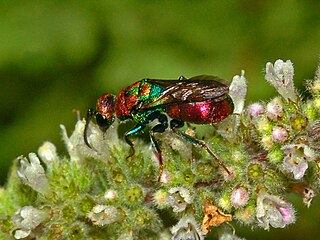
Hedychrum is a large genus of cuckoo wasps. With roughly 150 species, it is the second largest genus in the family; most species are from the Palaearctic, but they can be found in the Oriental, Afrotropical, Nearctic, and Neotropical regions. Their hosts are typically from the subfamily Philanthinae.
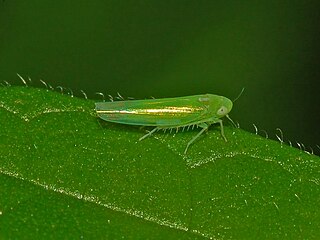
Empoasca is a genus of leafhoppers belonging to the family Cicadellidae subfamily Typhlocybinae.
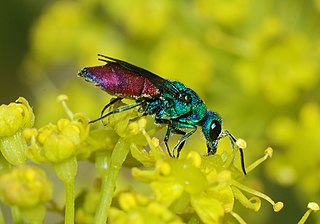
Chrysura is a genus of cuckoo wasps which parasitize megachilid bees. There are 117 species in Chrysura, all but 11 of which are found in the Palaearctic, making it the third largest genus in the family. The genus was described by Dahlbom in 1845, and the type species for the genus is Chrysura austriaca.

Holopyga is a genus of cuckoo wasps.

Crossocerus is a genus of square-headed wasps in the family Crabronidae. There are at least 250 described species in Crossocerus.

Pemphredon is a genus of digger wasps (Spheciformes) from the family Crabronidae. The genus is common in the Holarctic, with 12 species represented in Europe. Several species are considered beneficial because of their specialization in aphids.

Oxybelus is a genus of wasps in the family Crabronidae. The species are found worldwide except in the Australasian realm. They are especially represented in the Palearctic. Oxybelus is the largest genus in Crabronidae, with 264 species known. Oxybelus wasps sometimes gravitate towards people, flying around travellers and landing on them, even when they are shooed away. It is not known why they do it, however it might possibly be them trying to drink sweat for its minerals.

Stizoides is a genus of kleptoparasitic sand wasps in the family Crabronidae. There are at least 30 described species in Stizoides.

Psammotettix is a genus of true bugs belonging to the family Cicadellidae. The species of this genus are found in Eurasia and North America
Achorotile is a genus of true bugs belonging to the family Delphacidae.
Terellia plagiata is a species of tephritid or fruit flies in the genus Terellia of the family Tephritidae.

















